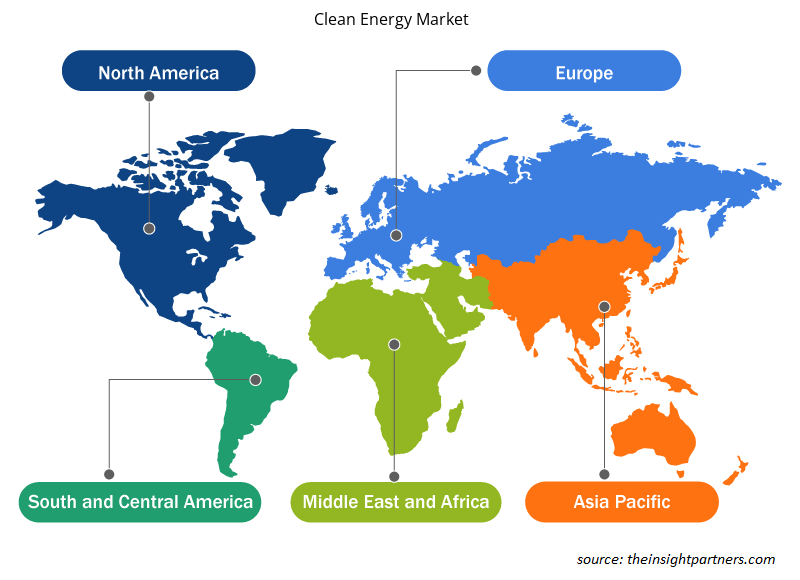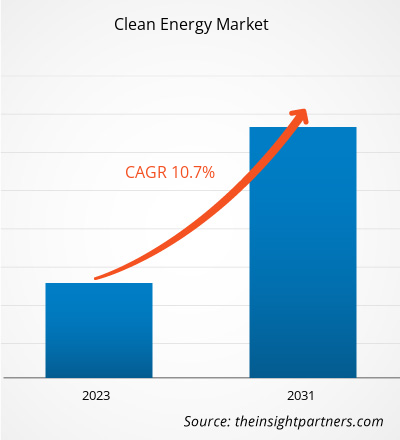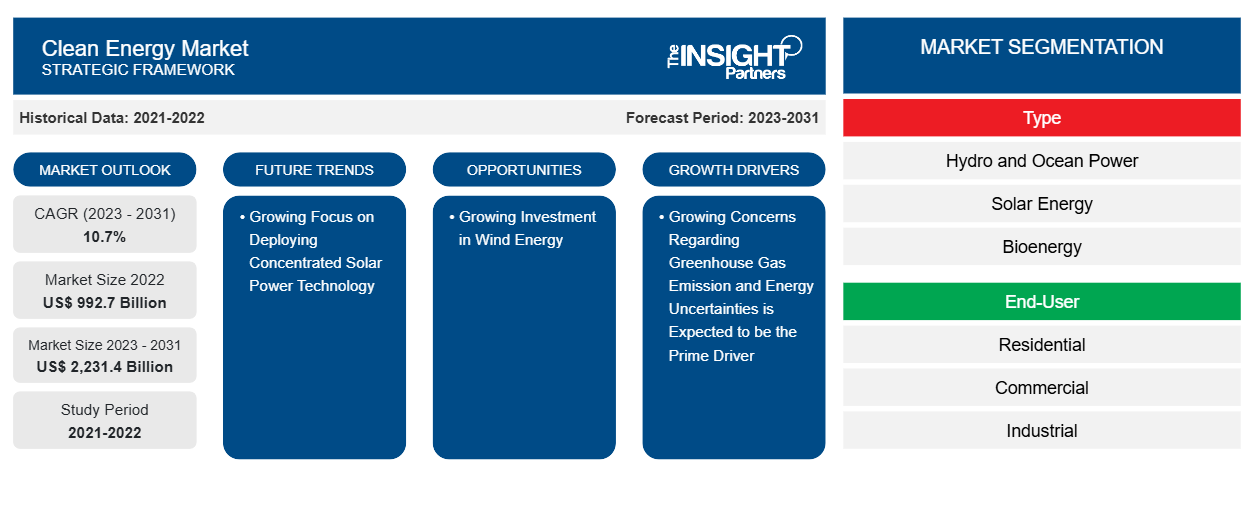Si prevede che la dimensione del mercato dell'energia pulita raggiungerà i 2.231,4 miliardi di dollari entro il 2031, rispetto ai 992,7 miliardi di dollari del 2022. Si prevede che il mercato registrerà un CAGR del 10,7% nel periodo 2023-2031. La crescente attenzione alla riduzione delle emissioni di gas serra, l'enfasi crescente sulle fonti di energia rinnovabile per promuovere la sostenibilità e la crescente preoccupazione per la protezione dell'ambiente rimarranno probabilmente tendenze chiave nel mercato.CAGR of 10.7% during 2023–2031. Growing focus on reducing GHG emissions, increasing emphasis on renewable energy sources for promoting sustainability, and rising concern toward environment protection are likely to remain key trends in the market.
Analisi del mercato dell'energia pulita
Le mutevoli circostanze energetiche in tutto il mondo stanno creando una domanda di fonti energetiche più sostenibili per soddisfare il crescente fabbisogno energetico. La crescente domanda di energia mette in mostra l'importanza delle fonti di energia pulita. Si prevede che l'aumento dei prezzi dell'energia e le incertezze di fornitura dovute a varie sfide geopolitiche stimoleranno la crescita del mercato dell'energia pulita durante il periodo di previsione. L'utilizzo di energia pulita aiuta a ridurre gli effetti ambientali negativi delle risorse energetiche standard come carbone e petrolio. Pertanto, i governi di diversi paesi in tutto il mondo hanno imposto incentivi fiscali e politiche favorevoli per incoraggiare l'adozione di fonti di energia pulita, che sta agendo come il principale fattore trainante per il mercato.
Panoramica del mercato dell'energia pulita
Con l'aumento della popolazione e dell'industrializzazione, anche la domanda di energia sta aumentando a livello globale. Ciò ha aumentato la necessità di fonti di energia alternative, poiché le risorse energetiche tradizionali come i combustibili fossili stanno indirizzando all'inquinamento ambientale. Le opzioni alternative pulite come l'energia solare ed eolica frenano le immense emissioni di carbonio e il loro impatto negativo sull'ambiente e aiutano a bilanciare la domanda e l'offerta di energia. Pertanto, l'aumento dello sviluppo del settore delle energie rinnovabili e le iniziative governative di supporto verso l'uso di un approccio sostenibile per ridurre le emissioni di carbonio stanno alimentando gli investimenti in fonti di energia pulita come l'energia eolica, solare, geotermica e idroelettrica.
Personalizza questo report in base alle tue esigenze
Riceverai la personalizzazione gratuita di qualsiasi report, comprese parti di questo report, o analisi a livello nazionale, pacchetto dati Excel, oltre a usufruire di grandi offerte e sconti per start-up e università
-
Scopri le principali tendenze di mercato in questo rapporto.Questo campione GRATUITO includerà analisi di dati che spaziano dalle tendenze di mercato alle stime e alle previsioni.
Driver e opportunità del mercato dell'energia pulita
Crescenti preoccupazioni per le emissioni di gas serra e le incertezze energetiche
Il progresso del sistema energetico in seguito all'accordo di Parigi, lanciato nel 2015 ed entrato in vigore nel 2016, ha stimolato l'utilizzo di fonti di energia pulita per ridurre le emissioni di carbonio. Un fattore chiave che contribuisce alle emissioni di gas serra che portano al cambiamento climatico è la produzione di energia tramite l'utilizzo di combustibili fossili. L'impiego di fonti di energia pulita, come solare, eolica, idroelettrica e geotermica, è in aumento a causa della crescente preoccupazione verso alternative energetiche più sostenibili e rispettose dell'ambiente, delle crescenti preoccupazioni sui cambiamenti climatici e delle iniziative governative di supporto per aumentare l'uso di energia pulita in tutto il mondo. I governi di diverse economie stanno riconoscendo l'importanza di passare a fonti pulite per soddisfare i futuri obiettivi di raggiungere emissioni di carbonio basse o pari a zero. Ad esempio, il governo degli Stati Uniti punta a ridurre le emissioni nette di gas serra di circa il 50-52% rispetto ai livelli del 2005 entro il 2030 e a raggiungere emissioni nette pari a zero entro il 2050. Allo stesso modo, il governo tedesco ha fissato un obiettivo per ridurre le sue emissioni di carbonio di circa il 65% rispetto ai livelli del 1990 entro il 2030.GHG emissions by ~50–52% compared to 2005 levels by 2030 and attain net zero emissions by 2050. Likewise, the German government has fixed a target to lower its carbon emissions by ~65% compared to 1990 levels by 2030.
A causa delle crescenti incertezze energetiche in Europa dovute alla guerra tra Russia e Ucraina, i governi di diversi paesi hanno identificato la capacità delle energie pulite generate a livello nazionale. Il mercato dell'energia pulita comprende fonti di energia, principalmente eolica, idroelettrica, geotermica e solare. Pertanto, le crescenti preoccupazioni relative alle emissioni di gas serra e alle incertezze energetiche stanno agendo come principali motori per il mercato dell'energia pulita.
Crescenti investimenti nell'energia eolica per stabilire fonti energetiche alternative
L'energia eolica, che aiuta principalmente a soddisfare la crescente domanda di energia in modo ecologico, sta emergendo come un'importante alternativa ai combustibili fossili. Inoltre, i governi di varie nazioni si stanno concentrando sugli investimenti in progetti eolici onshore e offshore per ridurre la dipendenza dai combustibili fossili per mitigare le emissioni di carbonio e i loro impatti tossici sull'ambiente. I progetti eolici offshore sono percepiti come più efficienti dei parchi eolici onshore grazie a una maggiore coerenza, velocità del vento più elevate e una mancanza di interferenza fisica dalla terraferma. Il crescente numero di progetti eolici offshore sta anche agendo come un importante fattore di spinta per la crescita del mercato dell'energia pulita a livello globale.
Analisi della segmentazione del rapporto sul mercato dell'energia pulita
I segmenti chiave che hanno contribuito alla derivazione dell'analisi del mercato dell'energia pulita sono la tipologia e l'utente finale.
- In base al tipo, il mercato dell'energia pulita è stato suddiviso in energia idroelettrica e oceanica, energia solare, bioenergia, energia geotermica ed energia eolica. Il segmento dell'energia idroelettrica e oceanica ha detenuto la quota di mercato maggiore nel 2023.
- In base all'utente finale, il mercato è stato segmentato in residenziale, commerciale e industriale. Il segmento residenziale ha dominato il mercato nel 2023.
Analisi della quota di mercato dell'energia pulita per area geografica
L'ambito geografico del rapporto sul mercato dell'energia pulita è suddiviso principalmente in cinque regioni: Nord America, Europa, Asia Pacifico, Medio Oriente e Africa, Sud e Centro America.
L'Asia Pacific ha dominato il mercato dell'energia pulita nel 2023. La popolazione in crescita e la crescente domanda di energia stanno agendo come un importante fattore trainante per il mercato dell'energia pulita nell'Asia Pacifica. Inoltre, la crescente attenzione del governo all'avvio di misure e politiche di supporto per ridurre la dipendenza dai combustibili fossili e ridurre le emissioni di carbonio guiderà molto probabilmente il mercato dell'energia pulita nella regione. Il crescente inquinamento ambientale e i duri impatti dei cambiamenti climatici sono le principali preoccupazioni che stanno stimolando la necessità di fonti di energia alternative pulite per ridurre l'utilizzo di combustibili fossili. Ad esempio, l'Indian Renewable Energy Development Agency offre prestiti a basso interesse per lo sviluppo di progetti di energia rinnovabile idonei nel paese. L'India ha puntato a raggiungere il 50% di energia elettrica cumulativa installata entro il 2030 da fonti rinnovabili e zero emissioni di carbonio nette entro il 2070. Inoltre, nel 2022, il governo ha introdotto un piano d'azione "Mission 500GW" per raggiungere l'obiettivo generale sulle energie rinnovabili.
Approfondimenti regionali sul mercato dell'energia pulita
Le tendenze regionali e i fattori che influenzano il Clean Energy Market durante il periodo di previsione sono stati ampiamente spiegati dagli analisti di Insight Partners. Questa sezione discute anche i segmenti del Clean Energy Market e la geografia in Nord America, Europa, Asia Pacifico, Medio Oriente e Africa, e Sud e Centro America.

- Ottieni i dati specifici regionali per il mercato dell'energia pulita
Ambito del rapporto sul mercato dell'energia pulita
| Attributo del report | Dettagli |
|---|---|
| Dimensioni del mercato nel 2022 | 992,7 miliardi di dollari USA |
| Dimensioni del mercato entro il 2031 | 2.231,4 miliardi di dollari USA |
| CAGR globale (2023-2031) | 10,7% |
| Dati storici | 2021-2022 |
| Periodo di previsione | 2023-2031 |
| Segmenti coperti |
Per tipo
|
| Regioni e Paesi coperti |
America del Nord
|
| Leader di mercato e profili aziendali chiave |
|
Densità degli attori del mercato dell'energia pulita: comprendere il suo impatto sulle dinamiche aziendali
Il mercato del mercato dell'energia pulita sta crescendo rapidamente, spinto dalla crescente domanda degli utenti finali dovuta a fattori quali l'evoluzione delle preferenze dei consumatori, i progressi tecnologici e una maggiore consapevolezza dei benefici del prodotto. Con l'aumento della domanda, le aziende stanno ampliando le loro offerte, innovando per soddisfare le esigenze dei consumatori e capitalizzando sulle tendenze emergenti, il che alimenta ulteriormente la crescita del mercato.
La densità degli operatori di mercato si riferisce alla distribuzione di aziende o società che operano in un particolare mercato o settore. Indica quanti concorrenti (operatori di mercato) sono presenti in un dato spazio di mercato in relazione alle sue dimensioni o al valore di mercato totale.
Le principali aziende che operano nel mercato dell'energia pulita sono:
- Società controllata da Xcel Energy Inc.
- EDF Energia
- Siemens Energia AG
- Enel SpA
- Andritz AG
Disclaimer : le aziende elencate sopra non sono classificate secondo un ordine particolare.

- Ottieni una panoramica dei principali attori del mercato dell'energia pulita
Notizie e sviluppi recenti sul mercato dell'energia pulita
Il mercato dell'energia pulita viene valutato raccogliendo dati qualitativi e quantitativi dopo la ricerca primaria e secondaria, che include importanti pubblicazioni aziendali, dati associativi e database. Di seguito sono elencati alcuni degli sviluppi nel mercato dell'energia pulita:
- Canadian Solar Inc. ha dichiarato che il governo municipale di Yangzhou City nella provincia di Jiangsu, in Cina, ha firmato un accordo di investimento pluriennale con la sua sussidiaria di maggioranza, CSI Solar Co Ltd. Secondo l'accordo, CSI Solar prevede di espandere la capacità del parco industriale di produzione di energia pulita di Yangzhou per la produzione di wafer, celle e moduli ad alta efficienza integrati verticalmente, nonché sistemi di batterie. (Fonte: comunicato stampa/sito Web aziendale/newsletter, gennaio 2023)
- Composites, Inc. (TPI) (Nasdaq: TPIC), un'azienda globale che punta su soluzioni innovative e sostenibili, ha annunciato di aver rinnovato i suoi accordi di fornitura con GE Renewable Energy fino al 2025. GE e TPI hanno inoltre elaborato una strategia per collaborare sui tipi di pale di prossima generazione di GE, inclusa la possibilità di totalizzare più linee di produzione nel 2023, oltre alle nove linee di produzione che GE ha in funzione con TPI. (Fonte: comunicato stampa/sito Web aziendale/newsletter, gennaio 2023)
Copertura e risultati del rapporto sul mercato dell'energia pulita
Il rapporto "Dimensioni e previsioni del mercato dell'energia pulita (2021-2031)" fornisce un'analisi dettagliata del mercato che copre le seguenti aree:
- Dimensioni e previsioni del mercato dell'energia pulita a livello globale, regionale e nazionale per tutti i segmenti di mercato chiave coperti dall'ambito
- Tendenze del mercato dell'energia pulita e dinamiche di mercato come driver, vincoli e opportunità chiave
- Analisi dettagliata delle cinque forze PEST/Porter e SWOT
- Analisi del mercato dell'energia pulita che copre le principali tendenze del mercato, il quadro globale e regionale, i principali attori, le normative e i recenti sviluppi del mercato
- Analisi del panorama industriale e della concorrenza che copre la concentrazione del mercato, l'analisi della mappa di calore, i principali attori e gli sviluppi recenti per il mercato dell'energia pulita
- Profili aziendali dettagliati
- Analisi storica (2 anni), anno base, previsione (7 anni) con CAGR
- Analisi PEST e SWOT
- Valore/volume delle dimensioni del mercato - Globale, Regionale, Nazionale
- Industria e panorama competitivo
- Set di dati Excel
Report recenti
Testimonianze
Motivo dell'acquisto
- Processo decisionale informato
- Comprensione delle dinamiche di mercato
- Analisi competitiva
- Analisi dei clienti
- Previsioni di mercato
- Mitigazione del rischio
- Pianificazione strategica
- Giustificazione degli investimenti
- Identificazione dei mercati emergenti
- Miglioramento delle strategie di marketing
- Aumento dell'efficienza operativa
- Allineamento alle tendenze normative























 Ottieni un campione gratuito per - Mercato dell'energia pulita
Ottieni un campione gratuito per - Mercato dell'energia pulita